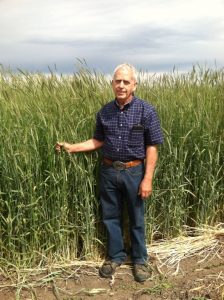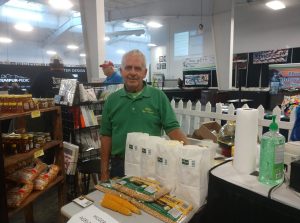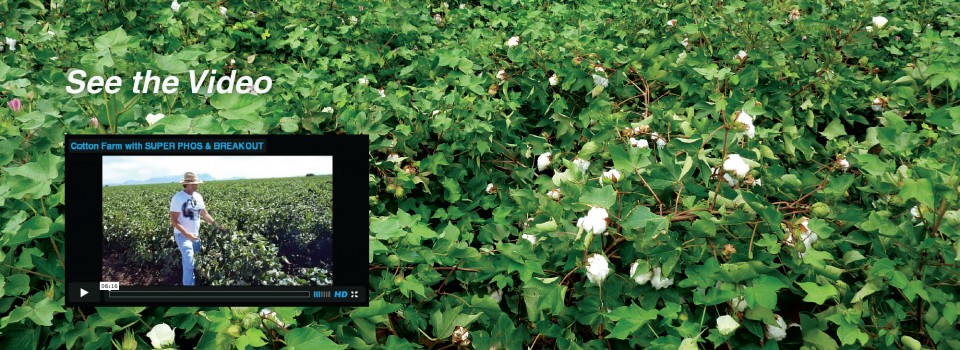 A recent field trial on green chile peppers has concluded that Promax® and Zap® treatment is noticeably effective in lowering the parasitic nematode population while improving the beneficial microbe population. This positive effect on the soil biology boosted the yield of green chile peppers and resulted in an increased profit for the farmer.
A recent field trial on green chile peppers has concluded that Promax® and Zap® treatment is noticeably effective in lowering the parasitic nematode population while improving the beneficial microbe population. This positive effect on the soil biology boosted the yield of green chile peppers and resulted in an increased profit for the farmer.
Field Trial: Promax® and Zap® Reduce Nematodes, Increase Yields for Green Chiles
Jason Garcia on Commercial Vegetable Growing with Huma Gro®
With Larry Cooper

Jason Garcia
Vegetable growers in Central Florida are preparing to get their beds ready for planting, so here’s my guide to how Huma Gro® can help growers get their best vegetable crops ever.
Bed Preparation
It’s become a pretty standard practice for Florida vegetable growers to fumigate their fields, then put down plastic and drip tape as their first steps in preparing planting beds for vegetables. Fumigation is generally considered to be a necessary—though expensive and sometimes controversial—first step to protect the coming crop from soil disease and nematode damage. Fumigation can be the most expensive part of vegetable production, and it comes with a host of safety precautions and restrictions that are a challenge for the grower and the surrounding community. But there is a Huma Gro® alternative that is much safer, has no restrictions, and can be up to half the cost of fumigation. [Read more…]
8 Simple Steps to Healthy Crop Soil

by Larry Cooper
8 SIMPLE STEPS TO HEALTHY CROP SOIL: A PREVIEW
Of course, you'll need to read this complete article to understand how and why each of these steps is essential for creating healthy crop soil, but here's a preview.
- Understand that soil is a living system.
- Measure and document your soil characteristics.
- Disturb the soil structure as little as possible.
- Bring plant diversity to the soil.
- Keep soil covered at all times.
- Keep living roots in the soil all year round.
- Build soil organic matter.
- Have a soil health plan: Review and revise it regularly.
Decline in soil health is one of the most potentially devastating world-wide crises of the 21st century, but the average person who does not farm probably never gives farm soil a second’s thought: The supermarkets are fully stocked—everything must be okay, right?
It’s not. A Reuters news headline from 2014 stated, “Only 60 Years of Farming Left If Soil Degradation Continues.” The article quoted the United Nations Food and Agriculture Organization (FAO) as saying that about a third of the world’s soil has already been degraded from chemical-heavy farming techniques, deforestation, and global warming. It was predicted that in 2050 the amount of agricultural land, in particular, would be only a quarter of the amount available in 1960—yet we will have 2 billion more people to feed.
What can be done about it? Quite a bit, actually; though reversing soil degradation and improving soil health is going to require changes in thinking and changes in some very hard-wired cultural practices. The 8 Simple Steps to Healthy Crop Soil that we’re about to discuss are culled from a variety of farming philosophies, some as old as time itself. You can find them in modern-era discussions of Regenerative Agriculture, Restoration Agriculture, and Conservation Agriculture, but they also draw from many aspects of “conventional” farming that were in place long before the concept of “conventional” included chemical fertilizers and pesticides. Most important, these steps are modeled on the practices followed by Nature itself in every undisturbed forest floor, unplowed prairie, and pristine mountain meadow.
The very best thing about the 8 Simple Steps to Healthy Crop Soil is that these practices can be profitably applied with good results by commercial farmers (conventional and organic), hobby farmers, community gardeners, even the “square-foot” backyard gardeners in the middle of a city. And while geography, soil type, and soil history certainly influence how the 8 Simple Steps to Healthy Crop Soil are implemented, implementing them all (and it has to be all of them) will lead to good results in all soil-based plant-growing situations.
What are the benefits of healthy soil?
Better Yields. Healthy soil produces more abundant crops of higher quality that are less susceptible to pests and diseases, more drought resistant, and better tolerant of wind, heavy rain, hail, heat, and all the other mayhem that keeps farmers up at night.
Economic Return. In addition to better yields, crops will require less chemical input in terms of fertilizers and pesticides. This won’t happen overnight, or even necessarily in the first year or two. But in the long term, growers will find their input expenditures greatly reduced.
A Farm for the Kids. Restoring health to the soil in a sustainable way means that growers will leave their kids a productive, profitable farm that the kids, in turn, can also leave in good shape for the grandkids.
Saved Planet. Though not necessarily our immediate goal, following the 8 Simple Steps to Healthy Crop Soil will increase the amount of carbon sequestered in the soil and lower CO2 levels in the atmosphere, which will help reduce global warming and give our grandkids’ grandkids a decent world in which they can live and prosper.
With these impressive benefits in mind, let’s dig deeper into how to create healthy crop soil.
Download/read the complete White Paper here.
Rye: A Popcorn Farmer’s Experience with Cover Crops

Dan Hilger in his 2nd year growing rye, May 2015
An Interview with Nebraska Farmer Dan Hilger
By Jael Batty
Nebraska farmer Dan Hilger recently incorporated rye into his corn and soybean crop rotation. Cover crops are a natural addition to Dan’s farming methods, which include minimum tillage and biostimulant inputs (Huma Gro® products). These practices increase soil health, reduce pest and weed pressure, and diversify his income.
In the following interview, we discuss the popcorn farmer’s rye growing practices. Continue reading
Popcorn Farmer Combats Current Farming Challenges

Daniel Hilger at the Nebraska State Fair
An Interview with Nebraska Farmer Dan Hilger
By Jael Batty
Popcorn grower Dan Hilger fights weeds, erosion, flooding, and low commodity prices with an innovative approach that improves his soil health.
The Nebraska farmer applies Huma Gro® products (biostimulants) to his soil to increase soil organic matter. Organic matter stimulates soil biology to break down nutrients and minerals for plant uptake. This keeps Hilger’s crops healthy enough that they naturally resist disease and insect pressure.
In addition to using biostimulants, the popcorn grower has been protecting his crops and the environment by practicing minimum tillage and growing rye cover crops.
In the following interview, we discuss the Nebraska farmer’s innovative approach and the influence that has led him to his current farm methods. Continue reading.
BHN Launches “The Huma Gro Farmer” Podcast
Bio Huma Netics, Inc. (BHN), has launched a new podcast series titled The Huma Gro Farmer. The podcast features episodes on how to “grow healthy”—featuring interviews with industry leaders on specific agriculture-related topics, how to use Huma Gro® products for superior results, and best practices for using product combinations for specific crops (early podcast episodes focused on strawberries). [Read more…]
The Huma Gro Farmer Podcast: Episode 2 – All Things Strawberry (Part 2)
Podcast: Play in new window
By Jael Batty
In Episode 2 of The Huma Gro Farmer podcast, we discuss All Things Strawberry from bud initiation to post-harvest with our strawberry brain trust: Huma Gro® Senior Director of U.S. Domestic Sales Doug Greer, Eastern Sales Manager and Agronomist Barrett Smith, Florida Regional Agronomist Jason Garcia, and special guests Certified Crop Advisor and Pest Control Advisor for WRT Ag in California Silvano DeLuna, and President of the strawberry dynasty Fancy Farms in Plant City, Florida Dustin Grooms. See show notes.
The Huma Gro Farmer Podcast: Episode 1 – All Things Strawberry (Part 1)
Podcast: Play in new window
By Jael Batty
Welcome to The Huma Gro Farmer podcast, in which we discuss crop nutrition and crop protection with experts in the field. Your host, Larry Cooper interviews agronomists, certified crop advisors, and Huma Gro distributors and customers about proven Huma Gro® programs and strategies for growing premium, high yield crops.
In Episode 1, we discuss All Things Strawberry from pre-plant to transplant with our strawberry brain trust: Huma Gro® Senior Director of U.S. Domestic Sales Doug Greer, Eastern Sales Manager and Agronomist Barrett Smith, Florida Regional Agronomist Jason Garcia, and special guests Certified Crop Advisor and Pest Control Advisor for WRT Ag in California Silvano DeLuna, and President of the strawberry dynasty Fancy Farms in Plant City, Florida Dustin Grooms.
Amazing Results with HUMA GRO® on Cotton Farm
 See what Russel said about his cotton farm and the results of applying HUMA GRO® SUPER PHOS™ and BREAKOUT® nutrients to the crop. Or see more videos here.
See what Russel said about his cotton farm and the results of applying HUMA GRO® SUPER PHOS™ and BREAKOUT® nutrients to the crop. Or see more videos here.
